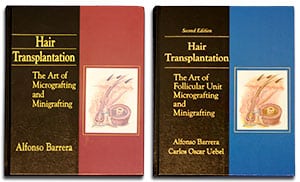
Plastic and Reconstructive Surgery - January 2015
BOOK REVIEW – pages 317, 318
As a service to our readers, Plastic and Reconstructive Surgery® reviews books, DVDs, practice management software, and electronic media items of educational interest to reconstructive and aesthetic surgeons. All items are copyrighted and available commercially. The Journal actively solicits information in digital format (e.g., CD-ROM and Internet offerings) for review.
Reviewers are selected on the basis of relevant interest. Reviews are solely the opinion of the reviewer; they are usually published as submitted, with only copy editing. Plastic and Reconstructive Surgery® does not endorse or recommend any review so published. Send books, DVDs, and any other material for consideration to: Ronald P. Gruber, M.D., Review Editor, Plastic and Reconstructive Surgery, Brookriver Executive Center, 8150 Brookriver Drive, Suite S-415, Dallas, Texas 75247.
Ronald P. Gruber, M.D.
Review Editor
Hair Transplantation: The Art of
Follicular Unit Micrografting and
Minigrafting, Second Edition
By Alfonso Barrera and Carlos Oscar Uebel. Pp. 448. CRC
Press, Boca Raton, Fla., 2013. Price: $325.
Although hair transplantation has been available for many decades, it has really been in the last 20 or so years that state-of-the-art techniques have developed. Hair restoration is no longer limited to male pattern baldness.
Today with current techniques, hair restoration is appropriate in both women with genetic hair loss and those who have had previous aesthetic surgery. Advances in hair transplantation have also made the technique appropriate for reconstruction of eyebrows, eyelashes, and beards. It is in this setting of an ever-expanding application of hair restoration options that Drs. Barrera and Uebel have produced their book, Hair Transplantation: The Art of Follicular Unit Micrografting and Minigrafting.
Drs. Barrera and Uebel have assembled a group of experts who have collectively created a textbook that adequately covers the entire spectrum of this field. The book begins with a thorough discussion of the fundamentals of hair restoration. This includes the anatomy and physiology of hair as well as proper patient evaluation and selection. Next, preoperative planning and patient management are thoroughly described. For the physician wishing to enter the field of hair restoration or those who are already experienced, this initial section of the book does an excellent job.
The next section focuses on surgical technique using the latest state-of-the-art methods. The most common use of hair restoration is in genetic male pattern baldness. This is one of the longer sections of the book and includes all aspects, including patient selection, patient management, and the mechanical details of performing the procedure. Hair restoration is a very technical, timeconsuming, and labor-intensive procedure. It requires not only the skill of the surgeon but also that of a well-trained team. This textbook does an excellent job of providing in great detail all the critical steps involved.
Another area of growing importance is the use of hair transplantation in women. This important topic is well covered, including the proper diagnosis of these patients as well as the appropriate surgical solutions.
Although the strip method of harvesting the donor site probably represents 60 to 70 percent of cases currently performed, follicular unit extraction is gaining increased popularity. In this method, the individual follicular units are harvested using a miniaturized coring method. This method can require greater surgical expertise and typically has a limit on the number of grafts that can be harvested in a single procedure. The benefit of the technique may be reduced potential linear scarring. This section is presented by Dr. James Harris, who is one of the early innovators and leaders with this technique.
A unique presentation in this book is use of the combined follicular unit extraction and strip technique in a single patient. One of the potential benefits of combining these two methods is the ability to harvest a large number of grafts at one time.
The book concludes with two final sections, one on special problems and the other on new areas of research in hair restoration. The section on special problems addresses management of those patients requiring reconstructive techniques after either traumatic injuries, such as burns, or major tissue resections. This is an important area that can often provide the patient with significant benefits.
This is a well-executed textbook covering all aspects of modern hair restoration. The authors do an outstanding job of providing both the neophyte and the experienced surgeon with an all-encompassing presentation. For anyone considering entering this field, as well as for those who have been involved in it for years, this is an invaluable resource.
DOI: 10.1097/PRS.0000000000000821
Jack Fisher, M.D.
Copyright
